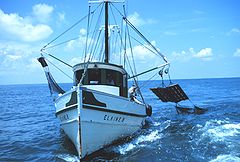Aquatic plant

Aquatic plants — also called hydrophytic plants or hydrophytes — are plants that have adapted to living in or on aquatic environments. Because living on or under water surface requires numerous special adaptations, aquatic plants can only grow in water or permanently saturated soil. Aquatic vascular plants can be ferns or angiosperms (from a variety of families, including among the monocots and dicots). Seaweeds are not vascular plants but multicellular marine algae, and therefore not typically included in the category of aquatic plants. As opposed to plants types such as mesophytes and xerophytes, hydrophytes do not have a problem in retaining water due to the abundance of water in its environment. This means the plant has less need to regulate transpiration (indeed, the regulation of transpiration would require more energy than the possible benefits incurred).
Characteristics of hydrophytes:
- A thin cuticle. Cuticles primarily prevent water loss, thus most hydrophytes have no need for cuticles.
- Stomata that are open most of time: so water is abundant. This means that guard cells on the stomata are generally inactive.
- An increased number of stomata, that can be on either side of leaves.
- A less rigid structure: water pressure supports them.
- flat leaves on surface plants for flotation.
- Air sacs for flotation.
- Smaller roots: water can diffuse directly into leaves.
- Feathery roots: no need to support the plant.
- Specialized roots able to take in oxygen.
For example, some species of buttercup (genus Ranunculus) float slightly submerged in water; only the flowers extend above the water. Their leaves and roots are long and thin and almost hair-like; this helps spread the mass of the plant over a wide area, making it more buoyant. Long roots and thin leaves also provide a greater surface area for uptake of mineral solutes and oxygen.
Wide flat leaves in water lilies (family Nymphaeaceae) help distribute weight over a large area, thus helping them float near surface.
Many fish keepers keep aquatic plants in their tanks to control phytoplankton and moss by removing metabolites.
Many species of aquatic plant are invasive species in different parts of the world. Aquatic plants make particularly good weeds because they reproduce vegetatively from fragments.
Contents |
Adaptations
- Free plants: In a pond community, they receive more sunlight than submerged plants. They also have to compete with one another for sunlight
- Submerged plants: Submerged leaves receive low levels of sunlight because light energy diminishes while passing through a water column.
All floating plants
- Have either air spaces trapped in their roots or large air spaces (aerenchyma) to help them float to obtain sunlight
- Have hair on their leaves to trap air
- Structural adaptation
Duckweed, water cabbage
- Chloroplast found on the top surface of the leaves
- Upper Surface has a thick, waxy cuticle to repel water and help to keep the stomata open and clear
- Structural adaptation
Water lily
- Structural material to reach higher points and receive more sunlight
- Structural adaptation
Floating heart, water lily, yellow pond-lily, water-shield
- Leaves tend to be broader without major lobbing, remain flat on water surface, maximize surface area and make use of full sunlight, chloroplasts found on the top of leaves
- Structural/ behavioral adaptation
Most partially-submerged plants
- Air spaces within the tissues to keep it buoyant so that its leaves can reach the top of the pond, maximizing the amount of sunlight received
- Structural adaptation
Dissected: parrots teather, Horn wort Thread-like: ditch-grass, quill wort
- Highly dissected/ divided leaves or thread-like ones, Allows for a bigger surface area (surface to volume – S/V)
- Structural adaptation
Hydrilla
- Elongates rapidly to reach water surface and branches out at water surface, more light can be obtained at water surface
- Structural/ behavioral adaptation
Human nutrition
Many aquatic plants are, or have been, used by humans as a food source. Note that especially in (South-east) Asia edible but uncooked hydrophytes are implicated in the transmission of fasciolopsiasis.[1] See also Fasciola hepatica.
- Wild rice (Zizania)
- Water caltrop (Trapa natans)
- Chinese water chestnut (Eleocharis dulcis)
- Indian Lotus (Nelumbo nucifera)
- Water spinach (Ipomoea aquatica)
- Watercress (Rorippa nasturtium-aquaticum)
- Watermimose, Water mimosa ? (Neptunia natans)
- Taro (Colocasia esculenta)
- Rice (Oryza) is originally not an aquatic plant.
- Bullrush, Cattail, (Typha)
- Water-pepper (Polygonum hydropiper)
- Wasabi (Wasabia japonica)
- kjosco? see also Fascioliasis
- Totora (Scirpus californicus)?
Animal nutrition
Some examples of aquatic plants
- Water hyacinth (Eichhornia)
- Duckweed: Lemna, Spirodela and Wolffia
- Trichanthera gigantea [2]
Some examples of aquatic plants
- Utricularia (from Latin, utriculus, a little bag or bottle) is a genus of slender aquatic plants, the leaves of which are furnished with floating bladders. They are called bladderworts.
- Water lettuce
Notes
Source
- Cook, C.D.K. (ed). 1974. Water Plants of the World. Dr W Junk Publishers, The Hague. ISBN 90-6193-024-3
See also
|
|
External links
- Advice for Planting Aquatic Plants
- 100's of Pictures of Aquatic Plants
- Algae Control Information on controlling algae
|
|||||||||||||||||||||||||||||
